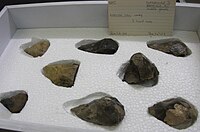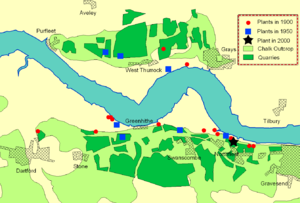Swanscombe
| Swanscombe | |
| Kent | |
|---|---|
| Location | |
| Grid reference: | TQ598747 |
| Location: | 51°26’57"N, 0°17’57"E |
| Data | |
| Population: | 6,300 (2005 est.) |
| Post town: | swanscombe |
| Postcode: | DA10 |
| Dialling code: | 01322 |
| Local Government | |
| Council: | Dartford |
| Parliamentary constituency: |
Dartford |
Swanscombe is a small town on the north Kent coast. It is an industrial town, involved heavily in the cement industry.
One of the large quarries created as a legacy of the cement industry, between Watling Street and the village of Stone, is the site of the Bluewater shopping complex, one of the largest such centres in Europe. [2004] It has been announced that an adjacent quarry is to be given up for housing – more than 10,000 houses will be built there.
Contents
Churches
The parish church is St Peter and St Paul. It is flint-built, partially Saxon. It had a spire on its tower until 1902, when the church was struck by lightning causing extensive damage. The parish register dates from 1559. George Cecil Renouard is buried in the Swanscombe churchyard.
Richard Norman Shaw (commonly known as Norman Shaw) built a church at Swanscombe for the workers of the cement industry, and it survives as a rare example of his design.
History
Prehistoric traces
Bone fragments and tools representing an earliest species of mankind have been found from 1935 onwards at the Barnfield Pit about a mile outside the village. This site is now the Swanscombe Heritage Park. Swanscombe Man (now thought to be female) was a late Homo erectus or an early Archaic Homo sapiens. The c. 400,000-year-old skull fragments are kept at the Natural History Museum in London with a replica on display at the Dartford Museum. Lower levels of the Barnfield Pit yielded evidence of an even earlier, more primitive human, dubbed Clactonian Man.
Nearby digs on land for the Channel Tunnel Rail Link]] revealed a c. 400,000-year-old site with human tools and the remains of a Straight-tusked Elephant (Palaeoloxodon antiquus), and evidence of water voles, pine voles, newts, frogs etc., indicating a site with standing water.
Early Middle Ages
During archaeological work undertaken at Ebbsfleet, before construction of High Speed 1, an Anglo-Saxon mill and a Roman villa were found near Swanscombe.
The terror from the sea, the Vikings, appear to be the origin of "deneholes", of which many have survived to this day. These were wells, cut deep into the chalk landscape, thought to be for concealing people and goods. They have a simple vertical shaft with short tunnels bearing horizontally from the base.
The Vikings eventually settled throughout the winter along the Thames Estuary with their ships, and established camps in Kent and Essex. In surveying the distribution of the many deneholes along the Thames corridor it would appear that Essex, on the northern shore of the Thames, sustained a greater influx of Vikings than did Kent, there being considerably more recorded deneholes in Essex, particularly around Orsett and Grays.
Archaeological digs and centuries of tilling have revealed a Danish fort and settlement, with pottery, anchors, weapons and some ships' timbers. The settlement was later variously called Suinescamp (in the Domesday Book), apparently from the Danish king Sweyn Forkbeard, father of Canute.
Other research suggests that deneholes might have been dug as a method of extracting chalk for use on the fields above, or the mining may have been a re-use of hole dug for defence. In any case, the practice of digging the holes reached a peak around the 13th – 14th centuries, long after the Viking raids had ceased.
1066 and the Treaty of Swanscombe
Local tradition has it that in 1066 Swanscombe locals massed an army in defiance of William the Bastard, and won for Kent the right to continue the ancient privileges. The men of Kent met William near Swanscombe, where the English concealed their number with branches, thus intimidating the Norman army. They were offered a truce that left Kent as the only region in England which William did not conquer, at least according to tradition. Kent's traditional motto is Invicta, meaning "unconquered".
Second World War
Just after 8 o'clock on the evening of Sunday 10 November 1940 a German bomb crashed down directly into The Morning Star Inn, causing in a single explosion, Swanscombe's worst wartime disaster. All that was left after the explosion was, where the pub had stood, a "heap of bricks and twisted rafters"¹ surrounding the smoldering pit that had been the cellar, although the staircase leading to the clubroom upstairs extended up out of the wreckage. Distressed families of those known to be in the pub at the time gathered at the street corners awaiting news of the casualties as bodies were gradually recovered from the ruins.
The official casualty lists revealed the death toll to be 27, with six others seriously injured and five people slightly hurt.
- "The landlord was amongst the dead, although his wife and son survived. The barmaid who was killed had given notice the week before the raid but had stayed on that evening because of the match. One of the other victims was a merchant seaman on seven days' leave who had spent two days travelling from Scotland to see his wife and children and was having a drink with his father in the pub at the time of the bombing: both were killed."[1]
On 30 July 1940 another Luftwaffe raid led to the death of over a dozen civilians, with 22 seriously injured. Its proximity to London and position under the German flight path to the city meant that Swanscombe fell victim to this kind of damage several times during the war.
On 30 July 1944 a V1 rocket landed on Taunton Road. Half of one side of the road was wiped out. 13 were killed and 22 seriously injured.[2]
Cement industry
Kent and its neighbours have abundant resources of clay and chalk. The first mining activity known in the area was for flint, a rock commonly found across the North and South Downs and in the Weald. This was used for tools.
Swanscombe was important in the early history of cement. The first cement manufacturing works near Swanscombe were opened at Northfleet by James Parker, around 1792, making "Roman cement" from cement stone brought from the Isle of Sheppey. James Frost opened a works at Swanscombe in 1825, using chalk from Galley Hill, having patented a new cement called British Cement. The Swanscombe plant was subsequently acquired by John Bazley White & Co, which became the largest component of Blue Circle Industries when it formed in 1900. It finally shut down in 1990. Between 1840 and 1930 it was the largest cement plant in Britain.
By 1882 several cement manufacturers were operating across the north Kent region, but the resulting dust pollution drove the people of Swanscombe to take legal action against the local cement works. Despite various technological innovations, the problem persisted into the 1950s, with telegraph lines over an inch thick in white dust. Modern cement kilns in Kent using chimneys 550 feet in height are now said to be the cleanest in the world. However, the neighbouring Medway towns are reported to be the most polluted inhabited area in the United Kingdom, and environmentalists claim that the cement industry contributes to acid rain in Scandinavia.
Blue Circle
The Associated Portland Cement Manufacturers (APCM), later known as Blue Circle Industries, came to the area in 1900 and by 1920 owned four local factories located at Swanscombe, Northfleet, Greenhithe and Stone.
By 1970 the North Kent cement industry had evolved to become the largest centre for the manufacture of cement in Europe, supporting a long tradition of research and development to perfect the processes used in the manufacture of chalk-based produce. Since then the industry has declined considerably due to the potential for more economic manufacture elsewhere, and currently (2007) only two operational kilns remain, both at Nothfleet.
Cricket club
There is one cricket club with its home in Swanscombe, Swanscombe and Greenhithe 1880 CC. Its home ground is at Broomfield Park. The club dates back to 1880.[3]
References
- ↑ Andrew Rootes (1980) "Front Line County"
- ↑ "Gravesend Reporter" Aug. 6th 1944 "Front Line County" Andrew Rootes (1980) Page 157.
- ↑ http://swanscombegreenhithe.play-cricket.com/home/home.asp swanscombegreenhithe.play-cricket.com
Outside links
| ("Wikimedia Commons" has material about Swanscombe) |

